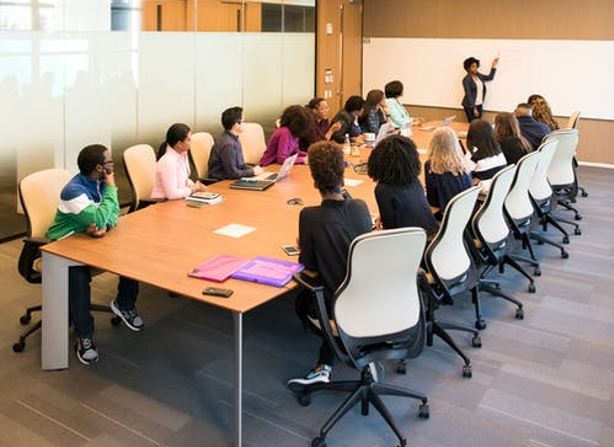In this post we will provide you with multiple sample questions, models answers and useful tips and techniques to prepare for APTIS speaking part 2.
In Part 2 of the APTIS speaking test, you will look at a photograph and describe express opinion and provide reasons and explanations.
In this part, you will be asked three questions. In the first question, you will be asked to describe what you see.
The second question will also be related to the topic but this time you will be asked to give an opinion on the topic of.
The third question will ask you to compare your life or experiences to the photograph.
For this part, your answers should be around 45 seconds long.
For the further details please visit British Council website here.
APTIS Speaking Part 2: Example Question #1
Part 2: In this part of the test, you are going to describe what is happening in a picture. Then, I will ask you two questions about it. You will have 45 seconds for each response.
Describe this picture.

1. Tell me about a time you learned something online.
2. Do you think people learn better online or in classrooms?
If you would like access to more simulated APTIS speaking tests then please visit our exam library here.
APTIS Speaking Part 2: Example Answer for Questions #1
Describe this picture.
In this picture, I can see a girl who is doing a lesson online. The teacher is explaining something, and the girl is listening and taking notes. The lecturer has drawn a weekly calendar on the board which makes me think that she is learning something related to time management. I also see that she has set up a very positive learning environment by having bright room, having some green plants around, got a sit next to window and has all her stationary close by. On the right-bottom, I see a wireless mouse and seems she utilizes available technology for her best use.
1. Tell me about a time you learned something online.
I have just completed my final year of high school and my classes were online for the second semester. It was really hard to pay attention, but I enjoyed my physical education class online the most because we were able to move around. Etc.
2. Do you think people learn better online or in classrooms?
I definitely think people learn better in classrooms. Face-to-face interaction is really important and I think a teacher can help you better when they are in the same room as you. Also you can always ask the professor if there is something unclear and discuss topics with colleagues. The living word is the word. In my opinion blended learning is the real deal.
Key Vocabulary For APTIS Speaking Part 2
Before looking at how to answer the question, we should look at some of the vocabulary you need to describe a photograph.
Look at the box below and make sure you know all of the phrases.

1. In the top left-hand corner.
2. At the top.
3. In the top right-hand corner.
4. On the left side.
5. In the middle
6. On the right side.
7. In the bottom left-hand corner.
8. At the bottom.
9. In the bottom right-hand corner.
Objects at the front of the picture are: In the foreground.
Objects at the back of the picture are: In the background.
It will help you very much to learn these phrases so that you use the correct articles and propositions, and because knowing the expression gives you something to say while you are thinking.
Below we will analyze first example question we provided above.
Question #1: Describe picture
Know the grammar.
Present continuous. For this part most of the tenses will be either present continuous- this will describe what the person is doing, or activities etc.
There is/There are. Also important are: There is a/some… There are some… So, revise those before the exam.
Prepositions are essential because you will need to describe where things are situated.

For the picture above you may be asked, What can you see in this picture?
The first thing you talk about is what you see.
You could answer, ‘In the foreground, I can see…. And in the background, there is…On the right-hand side there are some…
Don’t spend too long on describing what you can see. To answer this question well you have to speculate. You can do this by asking yourself the following questions:
• Who is the person?
• What are they wearing?
• Where is the person?
• What are they doing?
• How do they feel?
Language of Speculation
Some of the ways you can speculate on what you see are:
• I guess she’s…
• She could be…
• It looks like she’s… all are followed by + adjective, or noun, or gerund (verb+ ing)
• I get the impression that she’s…
• My initial impression is that she’d… (formal)
• She must/may/might/could/can’t be
You might also what to say how you feel about the photograph and give a reason.
• This photograph makes me feel… because…
• I don’t like this picture because…
• This picture gives me a…. feeling as…
Example answer: What can you see in this picture?
In the foreground of the picture, there is a girl or young woman. She is looking at a computer screen and on it, there’s a woman who looks like a teacher. The reason I think this is that she is sitting in front of a blackboard. The girl in the foreground has a notebook in front of her and looks as if she’s taking notes. In the middle of the picture, I can see a keyboard and on the left-hand side a wire basket and so it seems to me that the girl is having an online class.
Question 2
The second question is about your situation and experiences, for example: ‘Tell me a time when you learned something online’.
Know the grammar
Used to. If you get a question related to the past, an easy way to start is with: I used to + inf (for a past habit)
Example:
I used to enjoy doing to school but as I got older it became easier to learn from home…
or
I remember. I remember + ing (for a single past memory).
Example:
I remember getting my first table and thought how much easier it would make learning English.
Relative clauses mean that you can add extra information to a sentence. It means that you are using one sentence instead of two, and this lifts your level.
Use ‘Who’ for people. I learned a lot and he was the person who helped me most.
‘Where’ for places. This is the place where I learned to love music.
‘When’ for times. My school days were the time when I met my closest friends.
‘Which’ I am happy when I am gardening, which is good as I have a very big garden.
After that, you can talk about the things that happened using the past simple, or, if you feel confident and you want to impress the examiner, you can use the past continuous and the past perfect.
Remember you can get an idea about the grammar you need to use from the question.
Example answer: Tell me a time when you learned something online.
A few months ago I was working on a project and I found that I needed more information about online marketing, so I looked for a course. I found a course presented by Google that was free and so, I did that. I remember feeling strange at first because, although some great people were presenting the material, I had always learned things in a classroom and the feeling was very different. Anyway, I soon became comfortable with it and I ended up learning a lot of new things.
Question 3
The third question maybe something like: ‘Do you think people learn better online or in classrooms?’
Know the grammar
To answer the third question in Part 2 it is possible to only use the functional language for expression and justifying opinions. However, to get a higher score you can impress the examiner by using high-level structures.
The second conditional is useful in this section as you can talk about a hypothetical situation, for example:
I learn better in a class because if I learned online, there would be too many distractions.
The third conditional is useful if you can use it, as you can talk about a hypothetical situation in the past, for example:
If I hadn’t had the opportunity to learn in the classroom, I wouldn’t have learned as much.
Will/Going to + inf. In question 3 you may get the opportunity to make predictions. Use will for opinions/what people think and going to if there is evidence of a future event.
Expressing and Justifying opinions
This section generally wants you to express an opinion and some ways to do it are:
• If you ask me…
• Personally, I think (that)…
• It seems to me (that)…
• To my mind…
• I have no doubt (that)…
• In my view…
When we justify opinions, we usually give a reason for them. You should learn to do this automatically because it will make your English seem more natural and extend the time you are speaking.
Ways to justify are:
• Because…
• … is due to the fact (that)…
• I believe (that)…
• The evidence shows (that)…
• For this reason,…
• The reason is (that)…
Grammar note
You will need to learn which linking words are followed by a clause (sub + verb) and which are followed by a noun/noun phrase (article + adjective + noun) the examples above are all followed by a clause.
Example:
Because the weather was bad, we stayed at home.
However, we can change the structure if we use ‘because of…’ In that case, we need a noun phrase.
We stayed home because of the bad weather.
The grammar may seem complicated if you have not learned English grammar before. Don’t worry! You can still use high-level structures by learning a phrase and then using the important words (the content words) which suit you.
To speak at a natural speed for 45 seconds each of your answers should be about 100 words long. Go back to the section called ‘How to have something to say’ in the General Listening Tips and Strategies for advice on how to do this.
Example answer: Do you think people learn better online or in classrooms?
Personally, I think that people learn better in classrooms. The reason I believe this is that at the moment most people go to school and have lessons in a classroom. This is a habit and it takes a lot to change people’s habits. However, I think that this situation is changing and as online learning becomes more common, people will adapt to it and it will become more normal. Because of the advances in digital technology, it’s going to get easier and easier and soon classrooms will be forgotten.
APTIS Speaking Part 2: Example Question #2
Part 2: In this part of the test, you are going to describe what is happening in a picture. Then, I will ask you two questions about it. You will have 45 seconds for each response. Begin speaking when you hear this sound.
Describe this picture.

1. Tell me about a time that you went to a supermarket.
2. Do you think that it is better to shop in one big store, or in several smaller stores?
APTIS Speaking Part 2: Example Answer To Sample Question #2
Describe this picture.
i.e. In this picture, I can see a woman who is shopping for food at the supermarket. She has a lot of fruit in her trolley, such as oranges, pineapples and some vegetables and bottle of water too. She is taking bread now to add. On the mid-right, I see that there another girl who is also busy with shopping.
1. Tell me about a time that you went to a supermarket.
i.e. I usually go to the supermarket once a week. I like to go to a smaller one nearby my house because it is convenient. However, last week I went to a huge grocery store and I was impressed that they had many more products. Etc.
3. Do you think that it is better to shop in one big store, or in several smaller stores?
i.e. Although shopping in one big more store is usually more convenient, I think it can be expensive. When you go to a few smaller stores you can get better prices. It really depends on place you live in and things that you are shopping for.
APTIS Speaking Part 2: Example Question #3:
Part 2: In this part of the test, you are going to describe what is happening in a picture. Then, I will ask you two questions about it. You will have 45 seconds for each response.
What can you see in this photograph? 
1. What are the advantages of learning in a class?
2. Do you think online teaching will replace classroom learning?
APTIS Speaking Part 2: Example Answer To Sample Questions #3
What can you see in this photograph?
What this looks like to me is a classroom and from the people in it I guess that it’s a language class. There are about 14 students sitting at a desk and in the background, there is what must be a teacher. The teacher is pointing to something and the students are looking. On the desks I can see that most students have files or notebooks and at the bottom left-hand side of the photograph in the corner of the desk, it looks as if on of the students has her mobile phone.
1. What are the advantages of learning in a class?
I think that the biggest advantage is that there is personal feedback straight away. What I’m saying is that when you’re in a class your teacher can help you if you make a mistake, whereas online, you have to wait, and this could be a problem. Another advantage is with motivation. Some people need the atmosphere of a classroom to help them concentrate and when you're sitting at home with just you and your laptop, or whatever, it’s easy to get distracted. For me learning in a class is much better.
2. Do you think online teaching will replace classroom learning?
Yes, I think that’s going to happen especially if there are more pandemics. Despite that in my opinion, online learning is too effective not to replace the classroom. First, it’s convenient. You only have to have a connection and you can learn anywhere and this makes it very environmentally friendly too. Therefore, no one has to travel to a school, so no energy used. Next, all the materials are digital and that means no paper- no books etcetera. In my opinion, the sooner learning goes online, the better.



